What Leonardo DiCaprio can teach us about Hypothermia for the Medical Boards
It may be rarely seen in clinical practice–Indeed, a New England Journal of Medicine review article from 2012 approximates it being the cause of death of just 1500 patients in the United States–but accidental hypothermia is a topic found in the Pulmonary/Critical Care sections of the material in the In-Training Exam, USMLE, ABIM and PANCE boards. [1]
Along with another rare condition (bear mauling), it’s a diagnosis experienced by the main character in the latest Leonardo DiCaprio film, The Revenant, directed by Alejandro Innaritu. Feel free to take a study break from your test preparation to view the trailer of this Golden Globe winner here. As long as you finish reading this post afterwards, you won’t feel guilty.

Who is typically affected by accidental hypothermia?
According to MKSAP 17, the textbook description of victims of accidental hypothermia is a “young outdoor enthusiast in cold climates.” [2] Whether or not you consider DiCaprio’s 41 years of age to be young, his character in The Revenant (fur-trader Hugh Glass) is certainly an outdoor enthusiast braving cold climates. Despite this relation, keep in mind that hypothermia can occur in any region and at any age, and many elderly individuals are especially susceptible.
Aside from advanced age, what are other risk factors?
- Medical or Psychiatric Co-morbidities
- Malnutrition
- Homelessness
- Chemical dependency
How is Hypothermia classified?
Based on the temperature, in short.
- Mild hypothermia: Temperature between 32 and 35 C
- Moderate hypothermia: Temperature between 28 and 32 C
- Severe hypothermia: Temperature less than 28 C
What happens in each stage of Hypothermia?
When entering mild hypothermia, the body compensates cardiovascularly for the decrease in body temperature by increasing heart rate, blood pressure and respiratory rate. Shivering is a reflex to increase the body temperature. The mind remains alert but may experience poor judgment.
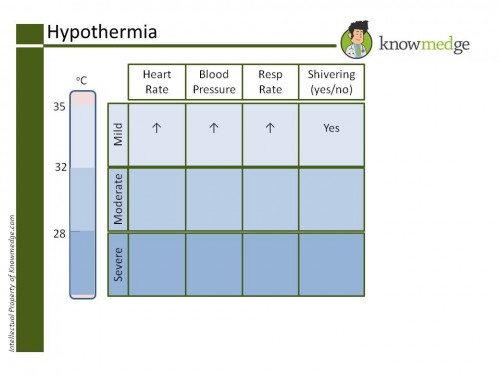
Progressing into moderate hypothermia, the heart rate, blood pressure, and respiratory rate all drop. There’s not enough energy to shiver and the body enters a somnolent state. Given the drop in cardiac output, renal perfusion is compromised and a drop in kidney function is noted. Supraventricular arrhythmias are detected on cardiac monitoring.
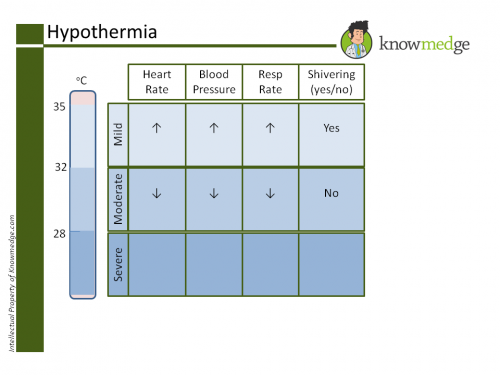
Osborn or J waves—which are positive deflections where the QRS complex meets the ST segment–may be seen in moderate hypothermia especially in the inferior and lateral leads. [3]
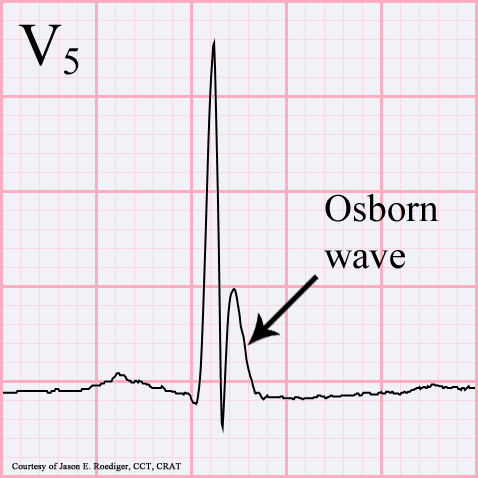
In severe hypothermia, patients become comatose with the development of asystole and apnea. Ventricular arrhythmias occur.
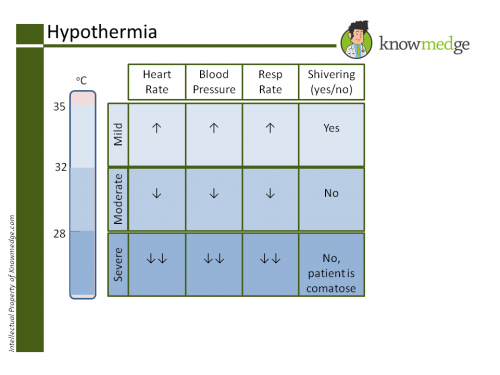
So how would Dicaprio have been managed if he made it to a hospital and the year was 2016, not 1823?
Management of hypothermia depends on the degree.
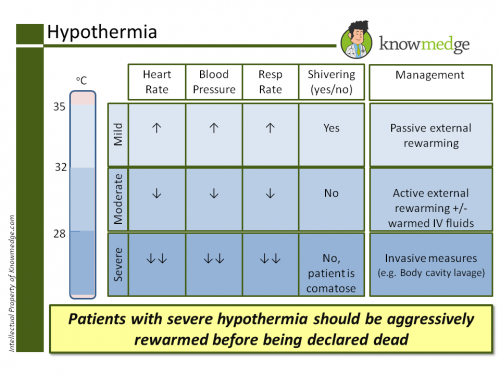
- Those with mild hypothermia require only passive external rewarming, provided their body is shivering. Passive external rewarming simply means to discard the patient’s wet clothing and apply an insulating cover over the body.
DiCaprio was in the moderate and severe stages of hypothermia at various times of the movie.
- Those with moderate hypothermia receive active external rewarming with heated cloth or air blankets. Warmed IV fluids can be added too, in order to minimize further drops in body temperature.
- Those with severe hypothermia are given body cavity lavage, via the colon, stomach, bladder, pleural space or peritoneum. Cardiopulmonary bypass provides the quickest rewarming rate. Given their presenting comatose state, patients with severe hypothermia must be aggressively rewarmed before being declared dead.
Lacking any of these interventions in the middle of a blizzard, (Spoiler alert!) Glass has to make do with removing the gut of his recently deceased horse, stripping off his own clothes and seeking refuge in the stomach of the horse to stay warm.
Don’t expect to find that as an answer choice. However, by reading the above post, you now know the important take-home points related to the diagnosis, signs/symptoms, and management of hypothermia, as tested on the In-Training Exam, USMLE, ABIM and PANCE boards.
References
[1] Douglas J.A. Brown, M.D., Hermann Brugger, M.D., Jeff Boyd, M.B., B.S., and Peter Paal, M.D. “Current Concepts Accidental Hypothermia.” New England Journal of Medicine. 367;20. November 15, 2012.
[2] “Accidental hypothermia.” MKSAP 17. Published by the American College of Physicians. 2015.
[3] Osborn wave. Wikipedia. https://en.wikipedia.org/wiki/Osborn_wave. Accessed January 24, 2016.







